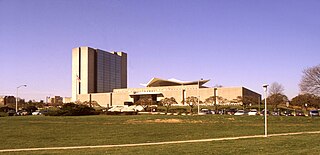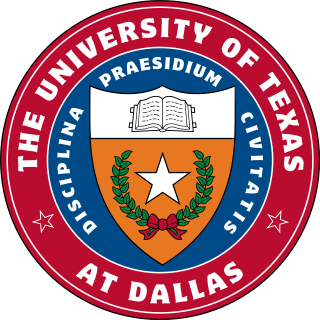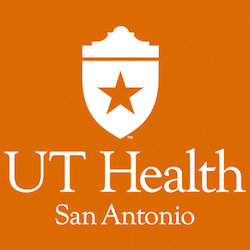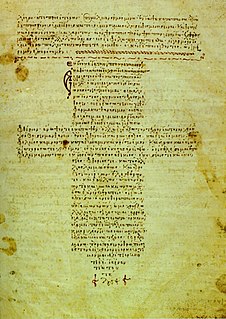MEDLINE is a bibliographic database of life sciences and biomedical information. It includes bibliographic information for articles from academic journals covering medicine, nursing, pharmacy, dentistry, veterinary medicine, and health care. MEDLINE also covers much of the literature in biology and biochemistry, as well as fields such as molecular evolution.

The United States National Library of Medicine (NLM), operated by the United States federal government, is the world's largest medical library.

PubMed is a free search engine accessing primarily the MEDLINE database of references and abstracts on life sciences and biomedical topics. The United States National Library of Medicine (NLM) at the National Institutes of Health maintains the database as part of the Entrez system of information retrieval.

The University of Texas at Dallas is a public research university in the University of Texas System. The main campus is in the Richardson, Texas, Telecom Corridor, 18 miles (29 km) north of Downtown Dallas. Approximately one-third of the campus is located within Dallas county, with plans to open an on-campus DART train stop on the Cotton Belt rail line (2022). The institution, established in 1961 as the Graduate Research Center of the Southwest and later renamed the Southwest Center for Advanced Studies (SCAS), began as a research arm of Texas Instruments. In 1969, the founders bequeathed SCAS to the state of Texas, officially creating The University of Texas at Dallas.

The Entrez Global Query Cross-Database Search System is a federated search engine, or web portal that allows users to search many discrete health sciences databases at the National Center for Biotechnology Information (NCBI) website. The NCBI is a part of the National Library of Medicine (NLM), which is itself a department of the National Institutes of Health (NIH), which in turn is a part of the United States Department of Health and Human Services. The name "Entrez" was chosen to reflect the spirit of welcoming the public to search the content available from the NLM.
The University of Texas Southwestern Medical Center is a medical education and biomedical research institution in Dallas, Texas, US. With approximately 14,400 employees and an operating budget of nearly $2.5 billion, UT Southwestern is one of six medical schools in the UT System. It is one of the largest medical schools in the country, annually training about 3,700 medical, graduate, and health professions students, residents, and postdoctoral fellows. Ongoing support from outside sources provides approximately $422.6 million per year to fund more than 5,700 research projects.
The Medical Library Association (MLA) is a nonprofit, educational organization with more than 4,000 health sciences information professional members and partners worldwide.

The University of Texas Health Science Center at San Antonio, d/b/a UT Health San Antonio is an institute of health science education and research located in the South Texas Medical Center, the medical district of the U.S. city of San Antonio, Texas. It is a component of the University of Texas System.

EBSCO Information Services, headquartered in Ipswich, Massachusetts, is a division of EBSCO Industries Inc., the third largest private company in Birmingham, Alabama, with annual sales of nearly $2 billion according to the BBJ's 2013 Book of Lists. EBSCO offers library resources to customers in academic, medical, K–12, public library, law, corporate, and government markets. Its products include EBSCONET, a complete e-resource management system, and EBSCOhost, which supplies a fee-based online research service with 375 full-text databases, a collection of 600,000-plus ebooks, subject indexes, point-of-care medical references, and an array of historical digital archives. In 2010, EBSCO introduced its EBSCO Discovery Service (EDS) to institutions, which allows searches of a portfolio of journals and magazines.
A health or medical library is designed to assist physicians, health professionals, students, patients, consumers, medical researchers, and information specialists in finding health and scientific information to improve, update, assess, or evaluate health care. Medical libraries are typically found in hospitals, medical schools, private industry, and in medical or health associations. A typical health or medical library has access to MEDLINE, a range of electronic resources, print and digital journal collections, and print reference books. The influence of open access (OA) and free searching via Google and PubMed has a major impact on the way medical libraries operate.
PubMed Central (PMC) is a free digital repository that archives publicly accessible full-text scholarly articles that have been published within the biomedical and life sciences journal literature. As one of the major research databases within the suite of resources that have been developed by the National Center for Biotechnology Information (NCBI), PubMed Central is much more than just a document repository. Submissions into PMC undergo an indexing and formatting procedure which results in enhanced metadata, medical ontology, and unique identifiers which all enrich the XML structured data for each article on deposit. Content within PMC can easily be interlinked to many other NCBI databases and accessed via Entrez search and retrieval systems, further enhancing the public's ability to freely discover, read and build upon this portfolio of biomedical knowledge.
eMedicine is an online clinical medical knowledge base founded in 1996 by Scott Plantz MD FAAEM, Jonathan Adler MD MS FACEP FAAEM, a computer engineer Jeffrey Berezin MS. The fundamental concept was to create a large repository of professional level medical content that could be both updated and accessed continuously to assist in clinical care and physician education. The eMedicine website consists of approximately 6,800 medical topic review articles, each of which is associated with one of 62 clinical subspecialty "textbooks". Pediatrics, for example, has 1,050 articles organized into 14 subspecialty "textbooks" ; the emergency medicine volume has 630 articles and internal medicine is near 1,400. If the remainder of the specialty textbooks are added to the total 6800+ articles were created in eMedicine. In addition, the knowledge base includes over 25,000 clinically multimedia files. To create this online content over 11,000 board certified healthcare specialists were recruited and managed in a first generation, proprietary learning management system (LMS). To provide some perspective on the amount of content that was created it is estimated that, if hard-copy printed out, it would total over 1 million pages.

Palmer College of Chiropractic is a private chiropractic college with its main campus in Davenport, Iowa. It was established in 1897 by Daniel David Palmer and was the first school of chiropractic in the world. The college's name was originally the Palmer School and Cure and later became the Palmer School of Chiropractic. Most early chiropractic schools were founded by Palmer alumni.

The Texas Blazers is an honorary service organization at The University of Texas at Austin that started in 1994. Its members are selected from the UT Student Body based on criteria including leadership, commitment to service, and academic achievement.

The Journal of Health and Social Behavior is a quarterly peer-reviewed academic journal published by SAGE Publications on behalf of the American Sociological Association. It covers the application of sociological concepts and methods to the understanding of health and illness and the organization of medicine and health care. The editors-in-chief are Richard M. Carpiano and Brian C. Kelly. Previous editors-in-chief include Gilbert Gee, Debra Umberson, and Eliza Pavalko.

A medical encyclopedia is a comprehensive written compendium that holds information about diseases, medical conditions, tests, symptoms, injuries, and surgeries. It may contain an extensive gallery of medicine-related photographs and illustrations. A medical encyclopedia provides information to readers about health questions. It may also contain some information about the history of diseases, the development of medical technology uses to detect diseases in its early phase. A licensed physician should be consulted for diagnosis and treatment of any and all medical conditions.

Natural Standard is an international research collaboration that systematically reviews scientific evidence on complementary and alternative medicine. Together with the faculty of Harvard Medical School, Natural Standard provides consumer information on complementary and alternative medicine for Harvard Health Publications and Susan G. Komen for the Cure. Natural Standard also provides information on herbal medicine and dietary supplements to MedlinePlus, which is produced and maintained by the U.S. National Library of Medicine (NLM) and the National Institutes of Health (NIH).
Health Disparities Centers refer to institutions that cover a broad range of needs and focus areas to decrease currently disproportionate illness and disease rates that lead to health disparities, as well as promote the engagement, empowerment and recruitment of underrepresented populations in health professions. Furthermore, many programs devote significant resources to developing cultural competency training to promote the deliverance of culturally sensitive healthcare by faculty, staff, as well as current and future healthcare providers. These services are usually tailored to meeting specific goals or missions of the individual components common in most of the operating Health Disparities Centers. The overall mission of Health Disparities Centers is to eradicate health disparities and improve health care.
David A. Kronick was a librarian who researched the history of scholarly communication. He was once called a "bibliographic archaeologist". He was a Fellow of the Medical Library Association and the American Association for the Advancement of Science, and achieved the rank of Distinguished Member in the Academy of Health Information Professionals.










